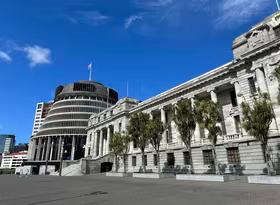VSR – variable savings rate or very silly regulation?
Firstly, credit where credit’s due. In announcing its new monetary policy proposals, Labour has shown an admirable ability to think outside the square. Past criticism of the monetary policy framework has implied that the Reserve Bank’s focus on inflation is too narrow and that it should take more account of other factors such as unemployment or the exchange rate. Although Labour’s policy has pinpointed the current account deficit as an area the Reserve Bank needs to take more notice of, the Party has coupled this assertion with an exploration of alternative tools to interest rates for moderating the economic cycle.
And so they’ve arrived at the variable savings rate, or VSR for short. In this brave new world, KiwiSaver would be compulsory, and instead of just using interest rates to slow growth and keep inflation under control, the Reserve Bank could also change the mandated rate of contribution to KiwiSaver. More saving is the same as paying more money on the mortgage, leaving less for discretionary spending, resulting in slower growth in consumption and aggregate demand, right? And the added bonus is that more saving will eliminate our current account deficit and stop so much of our money being sucked offshore by foreign-owned banks.
Unfortunately, there are a lot of problems with Labour’s idea and the assumptions behind it. From the bottom up:
- Should KiwiSaver be compulsory? It seems inevitable that compulsion will occur at some point in the future, given that over half of the voting-age population is now in the scheme. Of course, the main reason for KiwiSaver’s popularity is that we’re being bribed with our own tax money being given back to us.
Advocates for compulsory saving believe that we’re too stupid or short-sighted to prepare for our retirements, but I’d suggest it’s more a case of responding to guaranteed government superannuation, saving via non-financial assets such as property, and age and stage of life considerations (apart from the KiwiSaver bribe, few savings and investments are going to match the implied return of paying off your mortgage). Instances of short-sightedness about retirement savings are probably less common today given the significant education programmes undertaken through the Commission for Financial Literacy and Retirement Income over the last 20 years.
Forcing people to save against their will is ultimately welfare-reducing for society as a whole. One could argue that the current National Superannuation system funded via taxation is simply a form of compulsory retirement savings. That being the case, any move to compulsory KiwiSaver should be offset by a reduced tax burden over time. - Does New Zealand really have a savings problem? Data from the OCED shows that New Zealand’s household savings rate has improved from -9.7% in 2002 to +1.1% by 2013. There were clear reasons for concern about the lack of savings during the first half of last decade, but behaviour has changed significantly over recent years.
- How good is Australia’s compulsory savings scheme for their economy? Labour costs in Australia are widely recognised as being relatively high, at least partly due to the savings requirements. Ultimately these costs undermine Australia’s competitiveness on the international stage and potentially constrain economic growth over the medium-term.
- Do compulsory savings programmes actually increase savings anyway? Evidence from Australia suggests that their scheme has had little net effect on the household savings rate overall, but has mostly led to the reallocation of saving from one vehicle to another. Since KiwiSaver’s introduction in New Zealand, a similar outcome in saving behaviour here has been observed.
- What effect do compulsory and limited-access savings have on the robustness of financing decisions? In our view, the disproportionate flow of funds into certain investment vehicles reduces discipline around borrowing and lending activity. In the middle part of last decade in particular, it seemed that virtually all investment opportunities within Australia had been exhausted. As a result, there was a flood of funds coming out of Australia particularly from private equity firms, looking for alternative investments. Having free and functioning capital markets is good for an economy, but too much money sloshing around can see significant amounts of wealth being lost if economic conditions deteriorate and lenders to high-risk borrowers are left out of pocket.
Furthermore, varying the KiwiSaver contributions through the economic cycle is likely to mean that more funds flowing into equities and other investments during periods of strong economic growth when they are already relatively highly valued, exacerbating the lift in prices. The reverse would be true in a downturn, with the inflow of new funds drying up as KiwiSaver contributions were pared back. This recipe is not one for mitigating swings in the economic cycle. - Is New Zealand’s permanent current account deficit really a problem? Between 1951 and 1973 when New Zealand last ran a current account surplus, the country recorded current account deficits about three quarters of the time. Given that this period is seen as a golden age for the New Zealand economy, the figures are perhaps a little surprising.
The reality is that a country is able to sustainably run current account deficits as long as the current account deficit is smaller than nominal GDP growth. In other words, sustainability requires the level of overseas debt to increase no faster than a country’s income. This measure of sustainability comes about because, unlike an individual who should theoretically balance their income and spending over a lifetime, a country’s “lifespan” does not have an end and so there is no requirement to repay capital. - Are our “high” interest rates really caused by our rigid monetary policy framework? Labour thinks so. But looking at historical interest rate differentials suggests that, at least during the 1990s, our relatively high interest rates were a legacy of the high-inflation and high-risk environment for investors between the mid-1970s and late 1980s. Over the last decade or so, our real interest rates (ie after adjusting for inflation rates) are much closer to overseas rates. In fact, our real short-term and long-term interest rates have been lower than rates in the UK and the US over the last ten years.
- How much of our mortgage interest payments go overseas? The most recent data from the Reserve Bank shows that 30% of all bank funding is sourced from offshore. So if we assume that increases to the official cash rate push up borrowing and lending rates roughly equally, then most of the increased mortgage payments from an OCR hike flow through into increased income for domestic savers anyway. Implying that tighter monetary policy under the current framework leads to an equally large loss of New Zealand money overseas is misleading.
- Does the export sector really need a lower exchange rate? Labour believes that a lower dollar is necessary to improve the competitiveness of our exporters and boost our economic performance. To be fair, Labour isn’t the only organisation that finds this logic appealing. Calculations of what is a fair value for the exchange rate are problematic, but the reality is that much of the New Zealand dollar’s strength is attributable to the huge rise in export commodity prices over recent years. The lift in export commodity prices has been so strong that returns to agricultural-based exporters have risen by 22% over the last five years, even with the 41% lift in the dollar over the same period. The biggest struggle for exporters at the moment is for non-commodity manufacturers – a problem caused more by soft demand conditions in Australia than the high exchange rate.
Advocates of a lower exchange rate also conveniently overlook the significant implied loss of wealth a weaker dollar would imply. Dragging the exchange rate down is not going to change the minimum wage worker’s pay rate of $14.25 per hour, but they will notice the effects when they turn up at the petrol station and are charged $3.20/l instead of $2.20/l. - What about compliance costs for businesses? Last month our business adjusted all its wage and salary automatic payments for the changes to ACC levies at the start of the 2014/15 financial year. That task was arduous enough, but imagine having to change every employee’s pay every six weeks because the Reserve Bank has shifted the KiwiSaver contribution rate by 50 basis points. The additional work for HR and payroll managers or accountants would be significant.
In short, we’re not fans. In his speech announcing the policy, David Parker talked about how, “to [some] people, monetary policy is sacrosanct, a kind of infallible article of faith, and they vigilantly guard against meaningful change.” Yet research over the last decade has shown that, apart from a few possible tweaks around the edge, that New Zealand’s monetary policy framework is best practice.
Yes, there have been clear flaws with central banking operations highlighted by the Global Financial Crisis, but these problems were more to do with the appropriate levels of supervision, transparency, and regulation around the financial system and its institutions. In the wake of the GFC in New Zealand, the Reserve Bank has moved to alleviate many of these shortcomings.
Let’s also be realistic about how blunt an instrument the OCR is for trying to manage the economic cycle. But to achieve the same amount of traction with changes to KiwiSaver contributions would make the OCR look like a razor blade in comparison. Given that the OCR framework is transparent, reasonably quick to take effect, and has been set up to be highly independent, we’re happy to stick with it.








